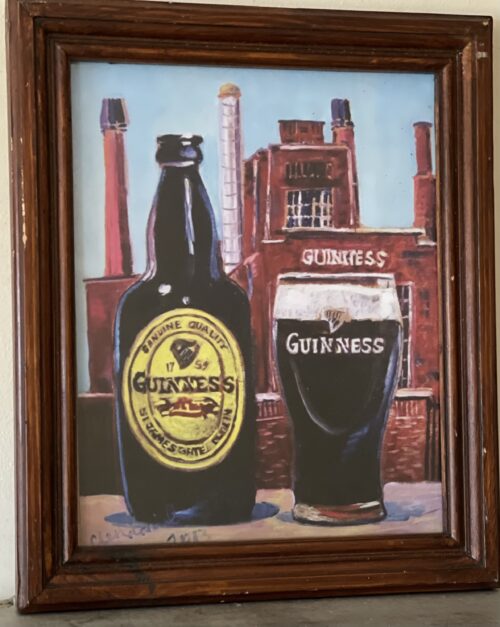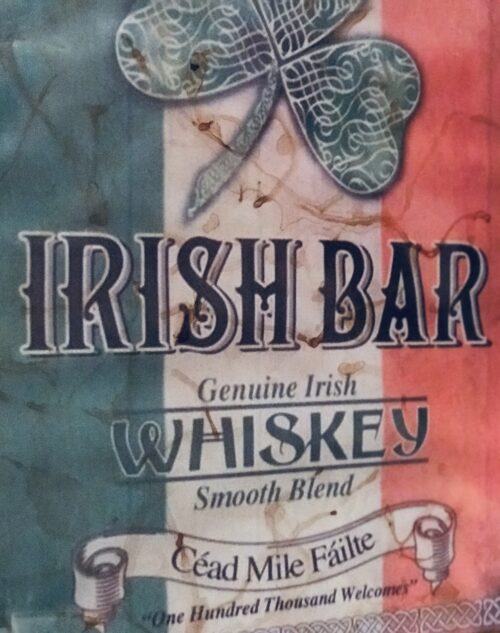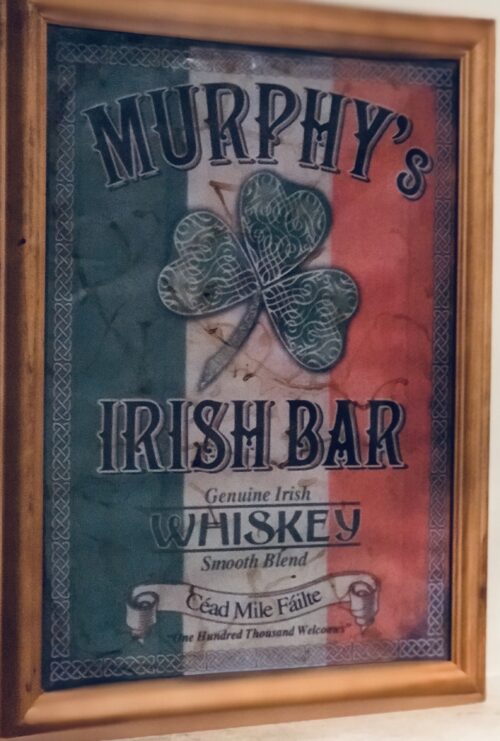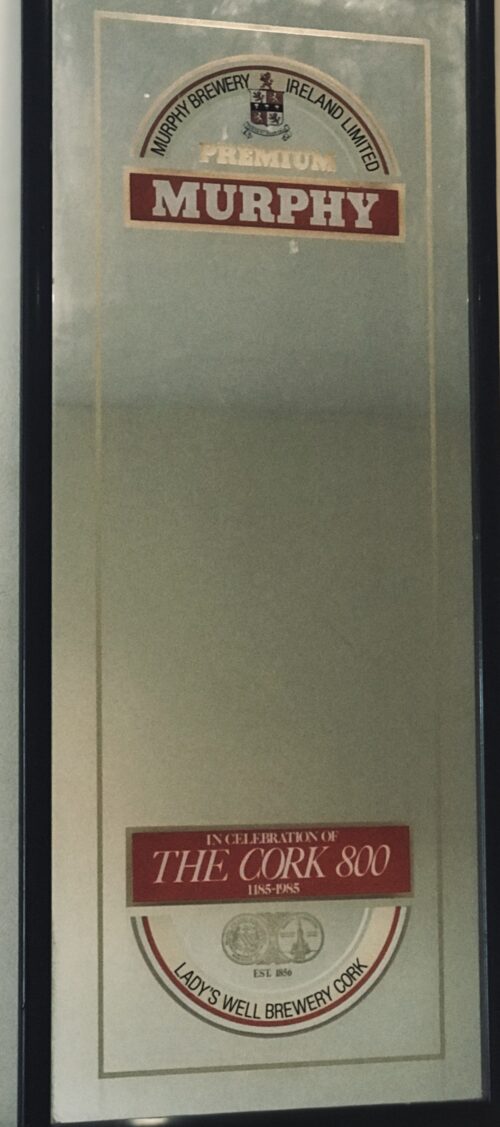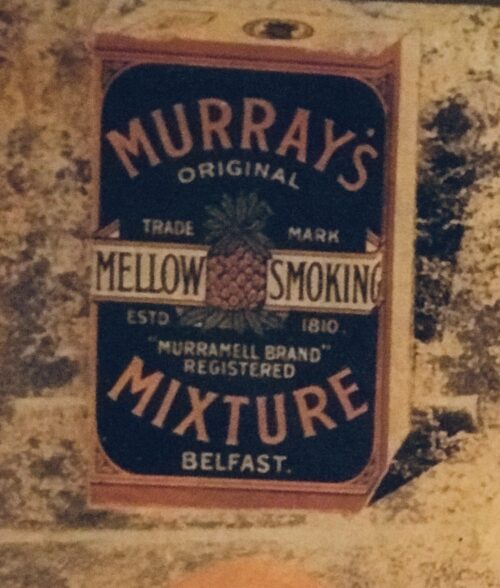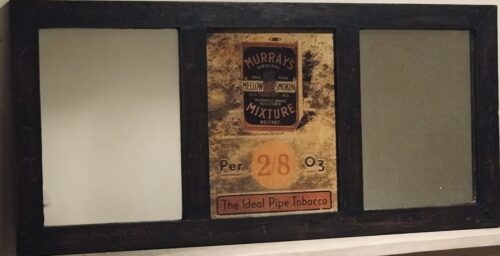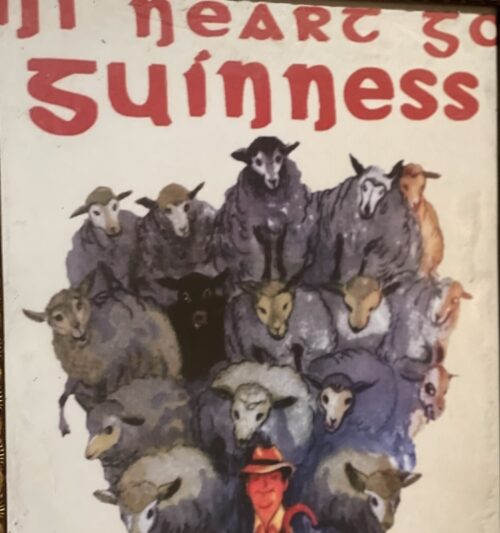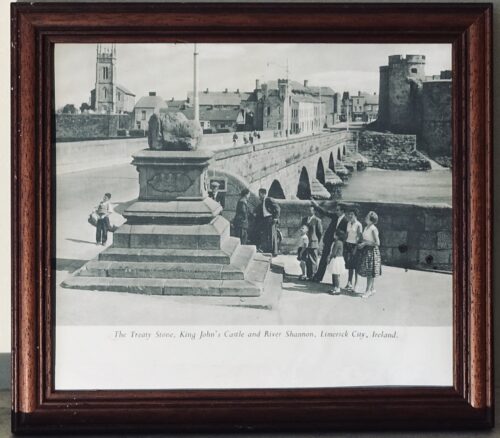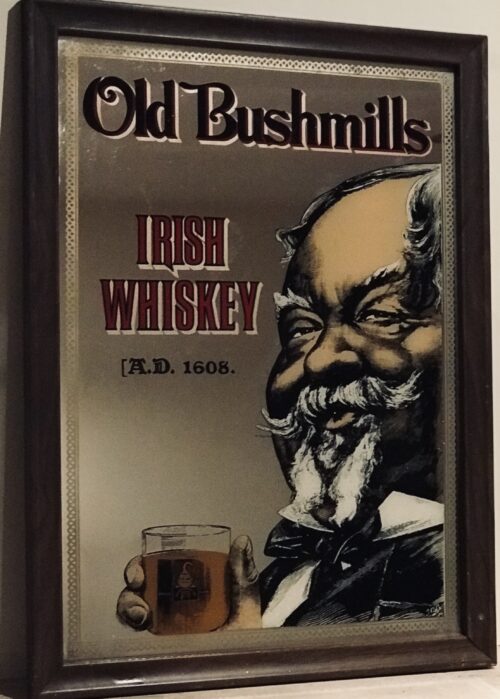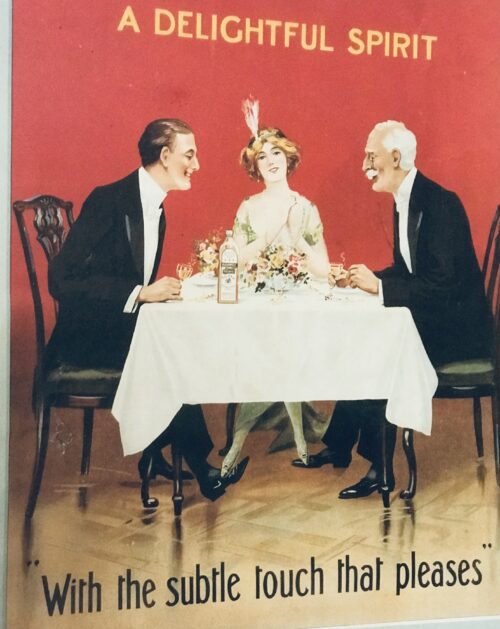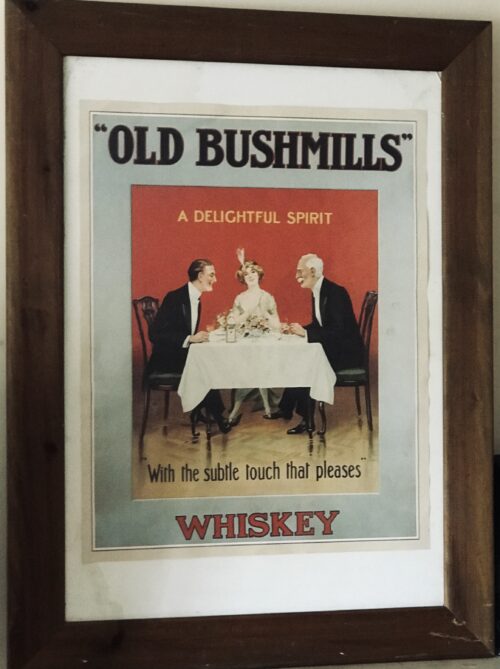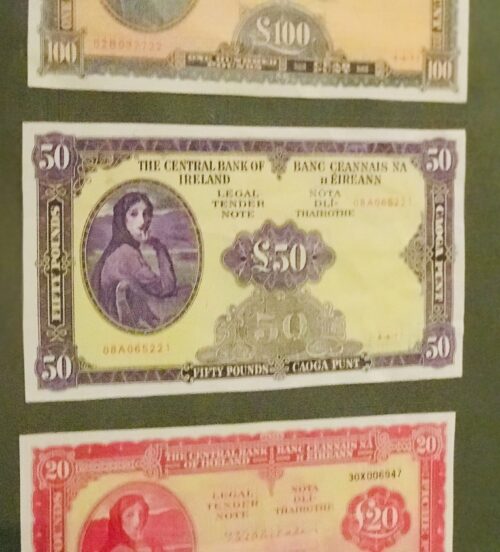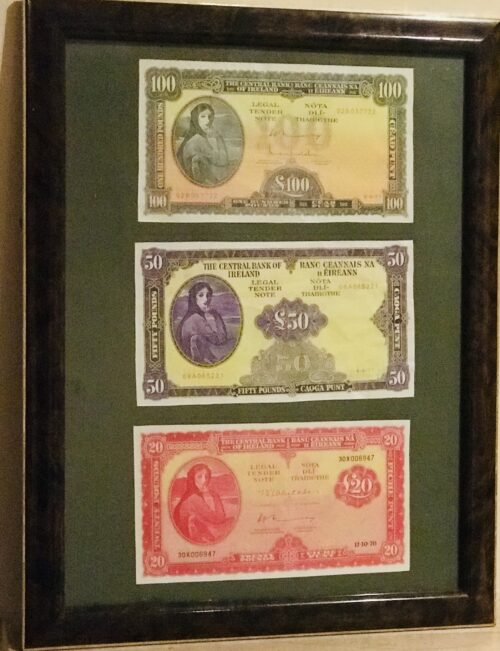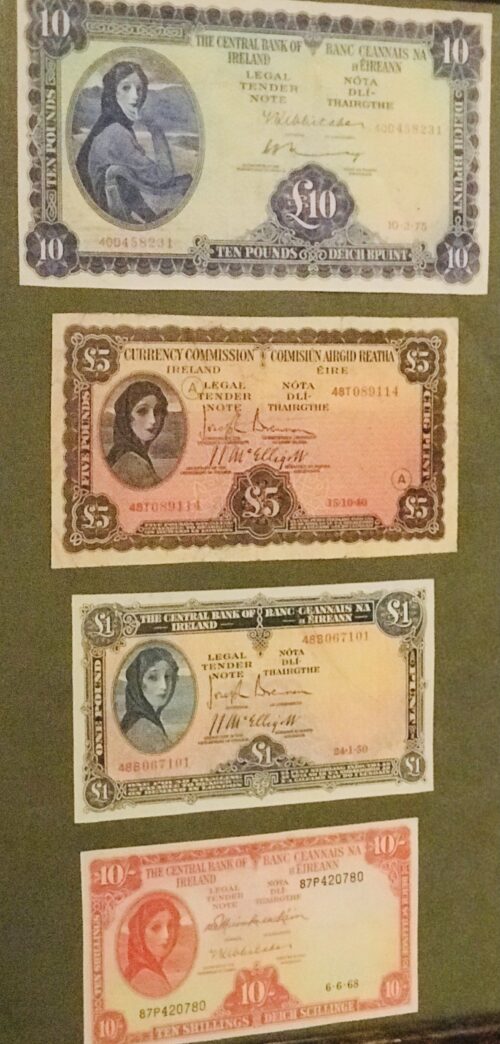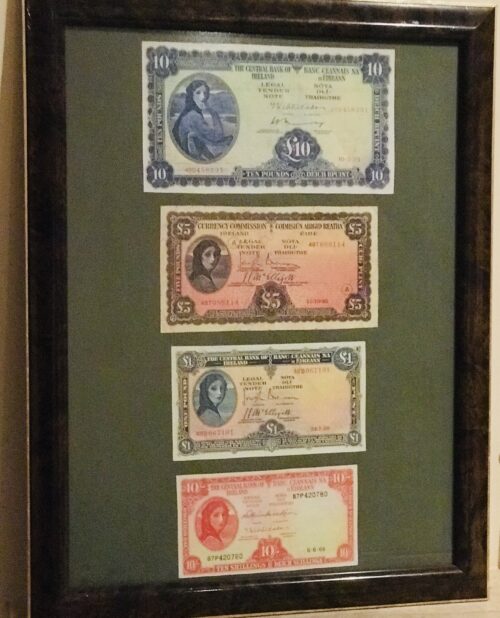26cm x 38cm Dublin
O'Connell Street connects the O'Connell Bridge to the south of Dublin with
Parnell Street to the north, and is roughly split into two sections bisected by
Henry Street. The
Luas tram system runs along the street.
During the 17th century, it was a narrow street known as Drogheda Street, named after Henry Moore,
Earl of Drogheda. It was widened in the late 18th century by the
Wide Streets Commission and renamed
Sackville Street after
Lionel Sackville, 1st Duke of Dorset. In 1924, it was renamed in honour of
Daniel O'Connell, a
nationalist leader of the early 19th century, whose statue stands at the lower end of the street, facing O'Connell Bridge.
The street has played an important part in Irish history and features several important monuments, including statues of O'Connell and union leader
James Larkin, and the
Dublin Spire. It formed the backdrop to one of the 1913
Dublin Lockout gatherings, the 1916
Easter Rising, the
Irish Civil War of 1922, the destruction of the
Nelson Pillar in 1966 and the
Dublin Riots in 2006. In the late 20th century, a comprehensive plan was began to restore the street back to its original 19th century character.

Sackville Street and Gardiner's Mall in the 1750s
O'Connell Street evolved from the earlier 17th-century Drogheda Street, laid out by
Henry Moore, 1st Earl of Drogheda. It was a third of the width of the present-day O'Connell Street, located on the site of the modern eastern carriageway and extending from
Parnell Street to the junction with
Abbey Street. In the 1740s, the banker and property developer
Luke Gardiner acquired the upper part of Drogheda Street extending down to
Henry Street as part of a land deal.He demolished the western side of Drogheda Street creating an exclusive elongated residential square 1,050 feet (320 m) long and 150 feet (46 m) wide, thus establishing the scale of the modern-day thoroughfare.
A number of properties were built along the new western side of the street, while the eastern side had many mansions, the grandest of which was Drogheda House rented by the
sixth Earl of Drogheda. Gardiner also laid out a mall down the central section of the street, lined with low granite walls and
obelisks.It was planted with trees a few years later. He titled the new development
Sackville Street after the then Lord Lieutenant of Ireland
Lionel Cranfield Sackville, Duke of Dorset.It was also known as 'Sackville Mall',
and 'Gardiner's Mall'.
However, due to the limited lands owned by the Gardiners in this area, the
Rotunda Hospital sited just off the street at the bottom of
Parnell Square – also developed by the family – was not built on axis with Sackville Street, terminating the vista. It had been Gardiner's intention to connect the new street through to the river, however, he died in 1755, with his son
Charlestaking over the estate.
Work did not start until 1757, when the city's planning body, the
Wide Streets Commission, obtained a financial grant from Parliament.For the next 10 years work progressed in demolishing a myriad of dwellings and other buildings, laying out the new roadway and building new terraces.The Wide Streets Commission had envisaged and realised marching terraces of unified and proportioned façades extending from the river.
Because of a dispute over land, a plot on the northwest of the street remained vacant; this later became the
General Post Office (GPO) which opened in 1814.The street became a commercial success upon the opening of
Carlisle Bridge, designed by
James Gandon, in 1792 for pedestrians and 1795 for all traffic.
19th century
Sackville Street prospered in the 19th century, though there were some difference between the Upper and Lower streets. Lower Sackville Street became successful as a commercial location; its terraces ambitiously lined with purpose-designed retail units. As a result, a difference between the two ends of the street developed: the planned lower end successful and bustling next to the river, and the upper end featuring a mixture of less prominent businesses and old townhouses. Upon his visit to Dublin in 1845,
William Makepeace Thackeray observed the street was "broad and handsome" but noted the upper section featured less distinctive architecture and had a distinct lack of patronage.

View of the Pillar and General Post Office c. 1830.
During the 19th century, Sackville street changed in character from the Wide Streets Commission design into a boulevard of individual buildings. One of the world's first purpose-built department stores was such a building: Delany's New Mart 'Monster Store' which opened in 1853 was later purchased by the Clery family.
It also housed the Imperial Hotel. Across the road, another elaborate hotel was built next to the GPO: the
Hotel Metropole, in a high-French style. Similarly, the
Gresham Hotel opened on Nos. 21–22 in 1817 to the north of the street in adjoining Georgian townhouses and was later remodelled, as it became more successful.

Trams on Sackville Street
As the fortunes of Upper Sackville Street began to improve in the second half of the century, other businesses began to open such as Turkish baths, later to be incorporated into the Hammam Hotel.
Standard Life Assurancebuilt their flagship Dublin branch on the street, while the Findlater family opened a branch of their successful chain close to Parnell Street, as did
Gilbey's Wine Merchants.
The thoroughfare also became the centre of the
Dublin tramways system, with many of the city's trams converging at the
Nelson Pillar.
By 1900, Sackville Street had become an important location for shopping and business, which led to it being called "Ireland's Main Street".
During the 19th century, the street began to be known as "O'Connell Street" though this was to be considered its "nationalist" name.Thus, the Dublin Corporation was anxious as early as the 1880s to change the name, but faced considerable objections from local residents, who in 1884 secured a Court order that the Corporation lacked the powers to make the change. The necessary powers were granted in 1890, but presumably, it was felt best to allow the new name to become popular. Over the years the name O'Connell Street gradually gained popular acceptance, and the name was changed officially, without any protest, in 1924.
Easter Rising and Independence

Buildings in Lower O'Connell Street, constructed between 1918 and 1923
On 31 August 1913, O'Connell Street saw the worst incident in the
Dublin lock-out, a major dispute between workers and the police. During a speech given by workers' rights activist
James Larkin, police charged through the attending crowd and arrested him. The crowd began to riot, resulting in two deaths, 200 arrests and numerous injuries.
During the
Easter Rising of 1916,
Irish republicans seized the General Post Office and
proclaimed the
Irish Republic, leading to the street's bombardment for a number of days by the gunboat
Helga of the
Royal Navy and several other artillery pieces which were brought up to fire on the north of the street. The thoroughfare also saw sustained small arms and sniper fire from surrounding areas. By Saturday, the rebels had been forced to abandon the GPO, which was burning, and held out in Moore Street until they surrendered.
Much of the street was reduced to rubble, the damaged areas including the whole eastern side of the street as far north as Cathedral Street, and the terrace in between the GPO and Abbey Street on the western side.In addition, during the chaos that accompanied the rebellion, the inhabitants of the nearby slums looted many of the shops on O'Connell Street.The events had a disastrous impact on the commercial life of the inner city, causing around £2.5 million worth of damage. Some businesses were closed up to 1923, or never reopened.
In the immediate aftermath of the Rising, the Dublin Reconstruction (Emergency Provisions) Act, 1916 was drafted with the aim of controlling the nature of reconstruction on the local area. The aim was to rebuild in a coherent and dignified fashion, using the opportunity to modernise the nature of commercial activity.
Under the act, the city was to approve all construction and reject anything that would not fit with the street's character. The reconstruction was supervised and by City Architect Horace T. O'Rourke. With the exception of its Sackville Street façade and portico, the General Post Office was destroyed.A new GPO was subsequently built behind the 1818 façade. Work began in 1924, with the Henry Street side the first to be erected with new retail units at street level, a public shopping arcade linking through to Princes Street, and new offices on the upper floors. The Public Office underneath the portico on O'Connell Street reopened in 1929.

Clerys department store, rebuilt in 1922
O'Connell Street saw another pitched battle in July 1922,
on the outbreak of the Irish Civil War, when anti-treaty fighters under
Oscar Traynoroccupied the street after pro-treaty
Irish National Army troops attacked the republican garrison in the nearby
Four Courts.Fighting lasted from 28 June until 5 July, when the National Army troops brought artillery up to point-blank range, under the cover of
armoured cars, to bombard the Republican-held buildings. Among the casualties was
Cathal Brugha, shot at close range. The effects of the week's fighting were largely confined to the northern end of the street, with the vast majority of the terrace north of Cathedral Street to Parnell Square being destroyed, as well as a few buildings on the north-western side. In total, around three-quarters of the properties on the street were destroyed or demolished between 1916 and 1922. As a result, only one Georgian townhouse remains on the street into the 21st century.
Because of the extensive destruction and rebuilding, most of the buildings on O'Connell Street date from the early 20th century. The only remaining original building still standing is No. 42 which now houses part of the
Royal Dublin Hotel.Apart from the GPO building, other significant properties rebuilt after the hostilities include the department store
Clerys which reopened in August 1922 and the Gresham Hotel which reopened in 1927.
Views from the pillar in 1964, looking south (left) and north (right)
Despite improvements to the street's architectural coherence between 1916 and 1922, the street has since suffered from a lack of planning. Like much of Dublin of that time, property speculators and developers were allowed to construct what were widely accepted to be inappropriately designed buildings, often entailing the demolition of historic properties in spite of its Conservation Area status. Several Victorian and 1920s buildings were demolished in the 1970s including Gilbey's at the northern end in 1972,
the Metropole and Capitol cinemas next to the GPO,
and the last intact Wide Streets Commission buildings on the street dating from the 1780s.They were replaced with a number of fast food restaurants, shops and offices, that continue to be the main features along O'Connell Street in the 21st century.
The street was given attention with Dublin City Council's O'Connell Street Integrated Area Plan (IAP) which was unveiled in 1998 with the aim of restoring the street to its former status. The plan was designed to go beyond simple cosmetic changes, and introduce control of the wider area beyond the street's buildings, including pedestrian and vehicle interaction, governance and preservation of architecture. Work on the plan was delayed, and reached approval in June 2003.
The main features of the plan included the widening of footpaths and a reduction in road space, removing and replacing all trees, a new plaza in front of the GPO,
and new street furnishings including custom-designed lampposts, litter bins and retail kiosks.
The plan included the
Spire of Dublin project, Dublin's tallest sculpture; constructed between December 2002 and January 2003, occupying the site of Nelson's Pillar.
Numerous monuments were restored, including those of late 19th century Irish political leader
Charles Stewart Parnell, radical early 20th-century labour leader
Jim Larkin, prominent businessman and nationalist MP Sir John Grey,
and the most challenging of all: the conservation of the O'Connell Monument standing guard at the southern entrance to the thoroughfare. This project was worked on for a number of months by an expert team of bronze and stone conservators before being unveiled in May 2005.
All public domain works were completed in June 2006, finalising the principal objective of the IAP at a cost of €40 million.
Work was disrupted by a
riot centred on the street which erupted on 25 February 2006. A protest against a planned Loyalist march degenerated into vandalism and looting, with building materials from the works in progress being used as weapons and for smashing windows and fixtures.
O'Connell Street has been designated an Architectural Conservation Area and an Area of Special Planning Control. This means that no buildings can be altered without Dublin City Council's permission, and fast food outlets, takeaways, cafes and amusement arcades are strictly controlled.
In June 2015, Clerys suddenly closed after it was bought out by investment group Natrium Ltd, with the loss of over 400 jobs.
In 2019, plans were announced to turn the premises into a four-star hotel.
The street is used as the main route of the annual St. Patrick's Day Parade,
and as the setting for the 1916 Commemoration every
Easter Sunday.
It also serves as a major bus route artery through the city centre. The modern tram,
the Luas, has undergone an extension and trams now run once again through O'Connell Street. It only travels in one direction, the return loop, to link the system at
St. Stephen's Green, runs via
Marlborough Street, parallel with and east of O'Connell Street.
Current and former monuments on O'Connell Street from south to north include:
Daniel O'Connell: designed and sculpted by
John Henry Foley and completed by his assistant Thomas Brock. Construction began in 1886 and the monument unveiled in 1883.
William Smith O'Brien: by Thomas Farrell. Originally erected in 1870 on an island at the O'Connell Bridge entrance to D'Olier Street, it was moved to O'Connell Street in 1929.

Parnell Monument at the north end of O'Connell Street.
Sir John Gray: by Thomas Farrell. Both plinth and statue carved entirely of white Sicilian marble, it was unveiled in 1879.Gray was the proprietor of the
Freeman's Journal newspaper and as a member of Dublin Corporation was responsible for the construction of the Dublin water supply system based on the
Vartry Reservoir.
James Larkin: by
Oisín Kelly. A bronze statue atop a Wicklow granite plinth, the monument was unveiled in 1980.
Anna Livia: by
Eamonn O'Doherty. Constructed in granite and unveiled on 17 June 1988, it became quickly known for its nickname "The Floosy in the Jacuzzi". It was removed in 2001 as part of the reconstruction plans for O'Connell Street and moved to the Croppies' Acre Memorial Park in 2011.
[63][64]
Nelson's Pillar, a 36.8 m (121 ft) granite Doric column erected in 1808 in honour of
Admiral Lord Nelson, formerly stood at the centre of the street on the site of the present-day Spire of Dublin. Blown up by republican activists in 1966, the site remained vacant until the erection of the Spire in 2003.
Father Theobald Mathew: by
Mary Redmond. The foundation stone was laid in 1890, and the monument unveiled in 1893. In 2016, the statue was removed to cater for the
Luas tram extension to the north of the city.
Charles Stewart Parnell:
Parnell Monument by Irish-American sculptor
Augustus Saint-Gaudens. The 37 ft high obelisk sits on a Galway granite pylon, was organised by John Redmond and paid for through public subscription and unveiled in 1911 at the junction with Parnell Street, just south of Parnell Square.
 Some original and rare Mitchell mirrors are still surviving today and can be found in some pubs in and around Belfast today
Some original and rare Mitchell mirrors are still surviving today and can be found in some pubs in and around Belfast today
 Some other examples of Mitchell Mirrors which were mass produced for advertising their products
Some other examples of Mitchell Mirrors which were mass produced for advertising their products









 Some original and rare Mitchell mirrors are still surviving today and can be found in some pubs in and around Belfast today
Some original and rare Mitchell mirrors are still surviving today and can be found in some pubs in and around Belfast today
 Some other examples of Mitchell Mirrors which were mass produced for advertising their products
Some other examples of Mitchell Mirrors which were mass produced for advertising their products










